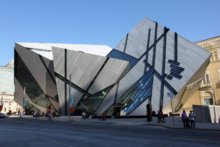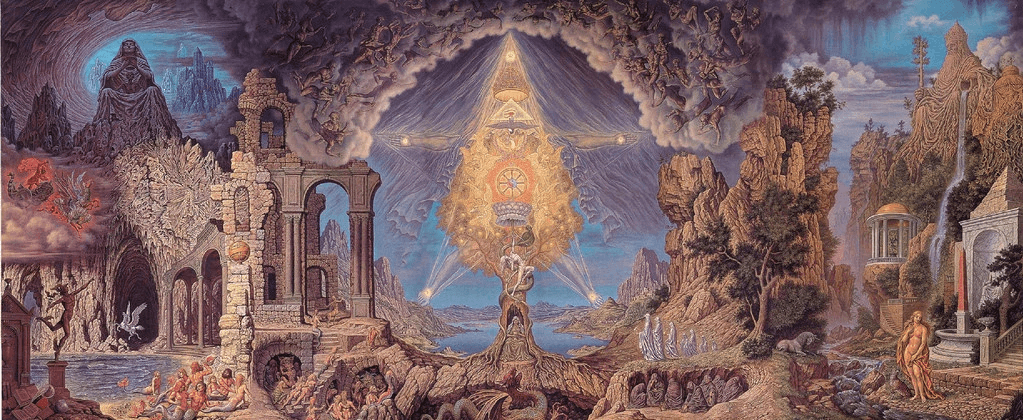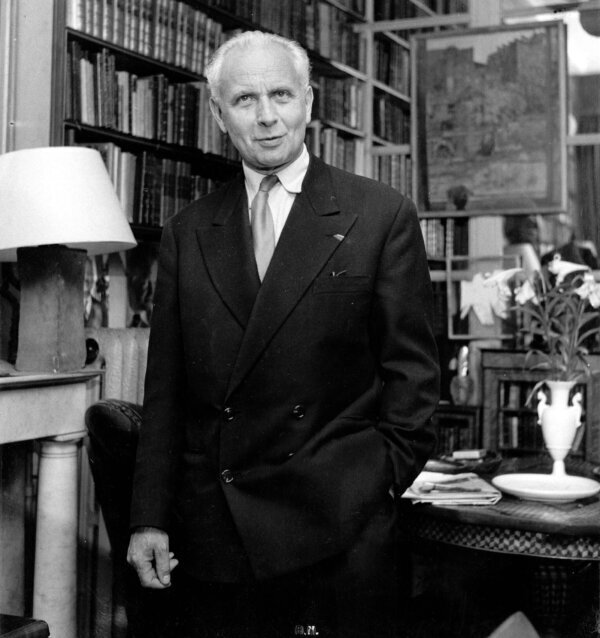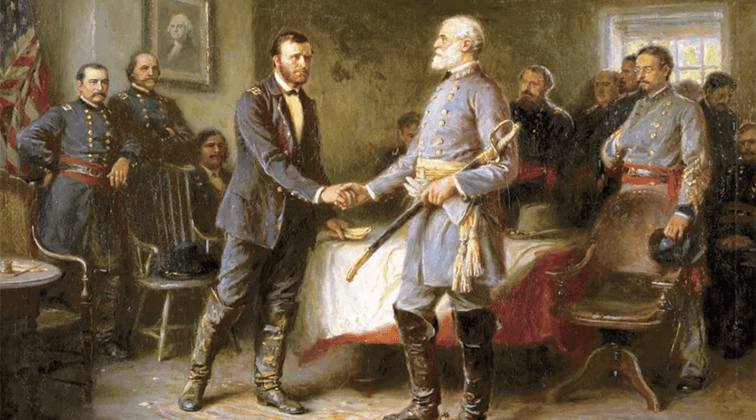The Royal Ontario Museum

The Royal Ontario Museum, known popularly as the ROM or “Rawm,” is a significant point of pride for Torontonians, residents of Ontario, and Canadians outside Ontario. It is one of the largest museums in North America, and certainly the largest in Canada. There are several “national” museums in Ottawa, but Ottawa is off in the woods somewhere; everyone knows where Canada’s Real National Museum is, and that is at University and Bloor.
The ROM was established in 1912 and is in some ways an old fashioned institution, being what one might call a department store museum, that is, one that covers a significant range of topics: natural history, arts, and world culture. Most modern museums specialize. We have one in Toronto dedicated to shoes. Just . . . shoes. But at the ROM you can get: mummies, dinosaurs, Indian canoes, rocks, stuffed bears, and Shang dynasty bronzes.
This makes it a natural for school trips of course, and a bussed-in afternoon at the ROM has been a school treat for generations of Ontario children, including the writer, all who have met, in their day, the famous sixty foot high Totem Pole in the old lobby.
There is nothing odd about this. The ROM is not the only institution of this type. The Smithsonian is the mother ship here in North America. We are informed there is a museum in Minneapolis that does for Minnesotans what the ROM does for residents of Ontario, and there’s New York.
What we want to get across, as a basis, are two points: (a) the ROM is very large and thoroughly respectable as a museum, and (b) it is loved real hard by a lot of people. And the same can be said of the Smithsonian and other fine institutions of this sort.
And now, as readers of this essay will guess, comes the problem.
For several years, we have been growing uneasy about the ROM. As far as we can see or define the problem, there is a dissonance in the museum as an institution, and this dissonance leads to a problem with the visitor’s experience at the ROM. We have to touch on the first question, to introduce the second question, which is the real topic of this nugatory stretch of pixels. This makes it a little lengthy, and we will divide this essay into two parts, and conclude next month.
Our unease is rather like that which occurs when we sense that a person to whom we are close is undergoing a spiritual crisis. The ROM seems to be pulling itself apart.
On the one side is its research wing (the part of the ROM that sends out expeditions and publishes papers and goes to conferences). This aspect of the museum is going great guns and has a solid, solid reputation.
On the other side are the public galleries, the bit the visitor meets. This side is increasingly bent on entertainment, and seems grimly determined to be popular. And in fact very popular it is too, and entertaining. But the two sides seem to have less and less to do with each other. The scholarly is still married to the popular, but the couple doesn’t talk much anymore.
In the long-long-ago when the writer had a waistline, the ROM operated from a position of assured authority, assured with the public, that is. Visitors assumed that they had to live up to it. If the average man did not comprehend exhibit X, or found it dull, that was the problem of the average man. Work harder at it, dammit. It’s good for you.
Harrumph.
No one in the museum business would dare operate on this basis now, at least as far as his or her public presentations. We will, we will keep your interest. You shall be entertained.
Unhappily this leads to a certain burking of the educational aspect. The exhibits are of course labeled, but there is no road from the exhibits to the scholarship behind them. There seems to be no accessible database of information about the artifacts, which for 2016 is shocking. The Chinese exhibit on the first floor, a virtual ocean of material, lacks a map to guide one around the huge space (there is a lot of stuff there).
This betrays a hidden assumption: only two kinds of people deal with the ROM—thoroughgoing experts (very few and already known to the staff) and people who are satisfied with a visual experience (many, many people—more than a million a year). Those who are not experts, but who would like to take something away with them (other than a t-shirt from the gift shop) are left to their own devices.
To psychoanalyze an institution is as tricky as psychoanalyzing a person, but we suspect that the cause below this dissonance is that the ROM does not have a solid reason to exist, a defined good, a telos. The museum was established in 1912, and on the ceiling of one of the older parts, set in a mosaic, are the words: That all men may know his work. There’s a transcendental purpose, and one on which we can all agree. Or we could if it was 1912. The mosaic is still there, but the entrance hall above which it is set has long been closed up, in favour of the Chin crystal, which you can read about in Wiki. And any director of the ROM who said this today, said it as the Director, would not be director very long.
So research goes on, keeps the mind busy, and entertainment goes on, and thought has been directed to the alley and the dumpsters.
The loss of existential purpose, the question of the good, is reflected in the problem that faces the serious visitor: How are we to get the good out of the ROM? Or out of any museum of the ROM class? How do we reach something in it that not only amuses and charms and moves us and diverts us but which edifies, edifies not in the sense of presenting something we approve of (harrumph!) but something that builds us up, that leaves us in some way better than when we came?
This is not a ghost question. Museum going costs time and effort, two things which, as we said last month, are short and costly. Does it not behove us to get the best we can from touring the Egyptian gallery, and keep something (and know that we keep it) from meeting the Dinosaurs?
We will leave our argument at this point, trapped in a locked room while poison gas pours in and water rises around it, and conclude next month.
Last month, we began by describing the ROM, both for its own sake, and as a type of similar museums, and for the sake of addressing two problems.
First, what is the ROM actually for? One side of the ROM is for professional researchers (the museum has a good reputation on this) and the other, for the public, dedicated to entertainment. But, we argued, there is no central good, at least no central good that may be cited in our tolerant secular society, from which its existence springs.
Now this is The Way We Live Now, and society will pay as much mind to our cavils as the people of Jerusalem did to Ezekiel.
But the other question touches us more closely.
What good can we get from the ROM ?
Well, fun, is the obvious answer, and true to boot. The mummies are fun, if creepy. They just are. The Chinese bronzes are fun and very cool indeed.
But fun is a symptom, not a cause. A good many things are fun, including scarfing cheesies.
Not to get all Aristotelian about it, but Fun is the result of Good, and to pick between “funs” (baseball to Game of Thrones) we need to be able to select from the range goods. And to do that we need to understand them, and that means causes and principles, and so on.
In other words, we want realities. Realities, as such, have properties. They are true, for one thing, and they have duration (sometimes long, often, alas, short) and they have consequences.
So here we are at the ROM, say on the third floor in Egyptian gallery, which is a very fun place, in front of the case with the model donkeys, and we ask:
What is here of truth?
What truth can I take away with me?
How can I build that truth into the fabric of my life?
What to do?
One approach might be called the Osmosis Technique.
In this, we resolve simply to spend a certain numbers of hours in our local museum, regularly, whether by week or month, and let the place…work on us. There would be no other requirement beyond saying, for example, I will spend two hours a week in the ROM, or other fine museum, for the next six months. After that I will search my heart and ask what I liked and didn’t like, and whether I am changed.
There are people who do this, but it is a phenomenon found more often in Art Galleries than museums. We read of one woman who visited her local gallery every day on her lunch hour, and sat in front of the same picture every time.
“Ain’t nuthing wrong with that,” as the song says, and there is a certain quiet appeal to this approach, but it requires patience and passivity. In North America we don’t do patience and passivity.
The second technique is to join your museum-going to a program of studies. Instead of ooh-ing and ah-ing about the birch bark canoe in the Canadian Aboriginal Peoples Gallery, bite the damn bullet and launch into a systematic investigation of Aboriginal affairs. That will keep you busy, and the next time you see that canoe it will mean something. Reality is very illuminating.
This is the road of heroes, and we salute those who decide to travel it. Nevertheless it requires a heavy investment of time and effort, and no one can expect to get into more than one or two fields of study.
This is more so, if we remember that to study something, for example numismatics, is pointless unless we maintain and use our new acquisition. Otherwise, nature edits, often with shocking speed. It is not like buying a book, it is like marrying someone.
Or we could try something a little more off-beat.
A museum is called a “museum” from the Greek mouseion: a place for the muses or for study (Webster’s New World Dictionary).
There has been a lot written about the muses, those Olympian blue-stockings, but we like what Eric Voegelin said. A few quotes:
They (the muses) were begotten by Zeus on Mnemosyne, to sing to the gods about the things that are, and shall be, and were aforetime.
Remembrance, in the sense of the Hesiodian symbol, does not recollect a dead past but “remembers” a presence that is a living presence only if it is fully conscious of its ordering victory over forces that once were just as victoriously present.
To which we may append some words from Dr. Mary Carruthers from The Book of Memory.
Thus, recollection was understood to be a re-enactment of experience, which involves cogitation and judgement, imagination, and emotion.
Hence, the ability of memory to re-collect and re-present past perceptions is the foundation of all moral training and excellence of judgement.
If we interpret this correctly (that’s a big “if”) we may gather two points:
The Muses do not inform, as such, but remind.
Recollection of the past is a prudential activity.
Might it be possible to consider the ROM, and other museums of the same kind, as vast brick and mortar aids to systematic and deliberate mindfulness?
Suppose one were to try something along these lines:
Commit oneself not just to visiting museum X, but to memorizing the layout of the building itself, to the point that one could reliably say, on floor one is such and such, in general terms, on floor two, on floor three and so on.
This is a clear and definite task. It is a thing to be done. When this is fixed in the mind (and it may take more effort than you expect), elaborate it: memorize the subsections of each floor, each with its subject.
You should now have in mind a mental model of the museum in question, and this is in turn a mini-model of the universe, as it is reflected in the arrangement of the building, as a portrait is a mini-model of the sitter.
Swell. And that gets us what?
Mainly, it could be reviewed in thought, at odd moments, for example on subway trips, as a way of freeing the consciousness from the immediate pressures around you, such as the situation at the office or the drunk in the next seat. It would be a big help to being mindful that there is more than is at hand. It ought to provide a distancing of the consciousness.
Further, since as everything is intelligible, in part, in terms of its relationships with everything else (we understand a cat, in part, because it is like and unlike a elephant) such a structure in memory allows comparison of elements, comparisons that might not otherwise occur to one. Egypt is on floor three, and dinosaurs on two – but if you have both in mind as part of a definite (if mental) reality, you may come to wonder about how Egypt relates to dinosaurs. That will kill the rest of the staff-meeting.
This sort of goings-on has a couple of other advantages.
First, it is dead cheap. It requires time and effort, but no more equipment than a notebook, and that only temporarily. The time required can often be found in the dead spaces that fill so many of our days.
Second, it is easily intensified. After fixing in mind, to the point that it can be easily recalled, that the gallery with antique armor is on floor…three…on the…west side, one can advance to recollecting the individual cases in the gallery, and the individual objects. As one gets closer to individual objects, the payoff in pleasure when you can remember them increases (naturally, since you are focusing on real goods). The more items, of course, the more elements for contemplation.
With such a program, we would being doing something definite as far as the ROM (“doing” and “definite” are characteristic of reality), we would be establishing something we could take away from the experience, we would be addressing the whole museum and taking advantage of its unity, and the business would be philosophically kosher. Also, the systemic exercise of the memory is likely to reveal certain limitations, ones you didn’t know you had, and won’t that be edifying?
Two points to conclude:
First, this is a suggestion, and only a suggestion. If one of our readers has a better plan for extracting the best from a museum, juicing the ROM as it were, let he or she be charitable and let us know. It is vital to reach the right. To care about who was correct about what was is vulgar, as Valery notes.
Second, the writer of these words is visited with the crushing realization that he is now beholden to actually try this. Very well, we hope to report on the idea in the fall. Could be a long summer.




